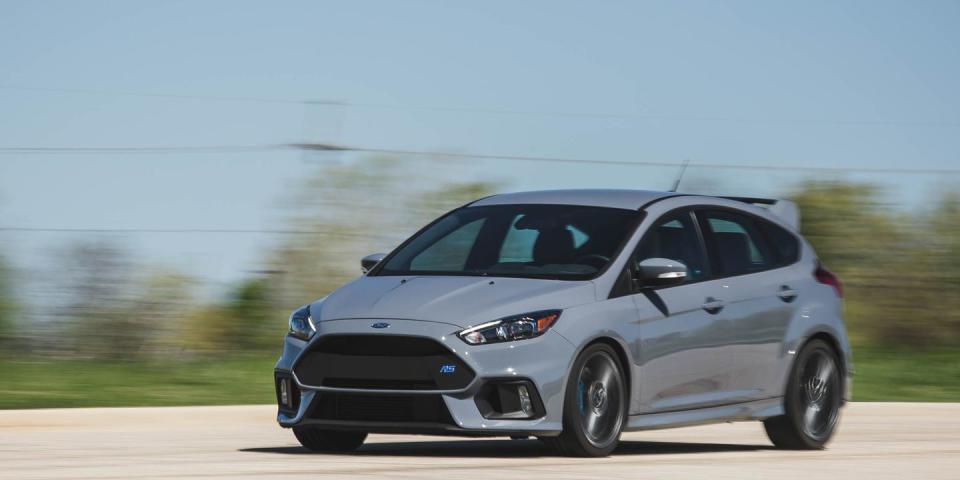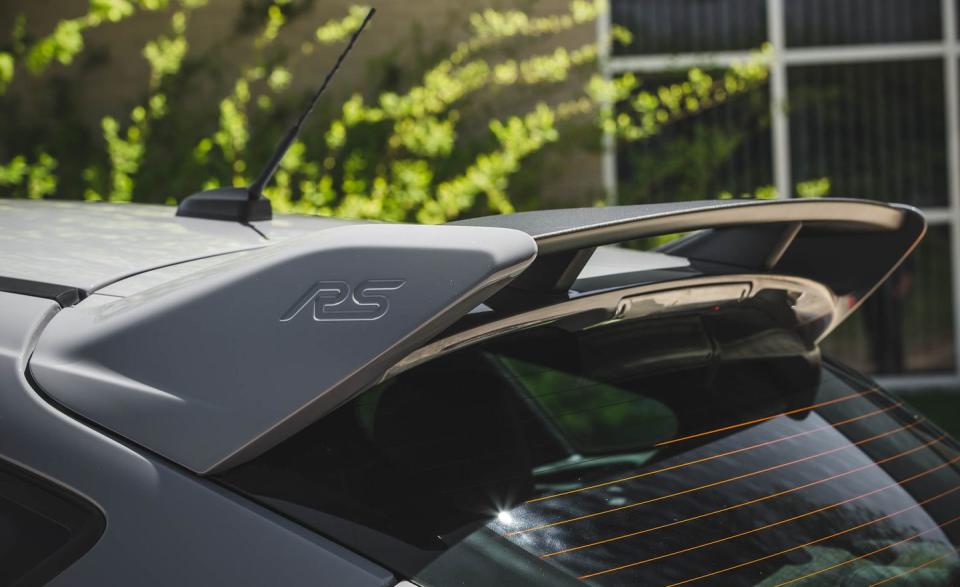Watch Us Play with Ford's Drift Stick for the Focus RS

Using a car’s hand brake to make an abrupt 180-degree loop in an open parking lot might as well be a rite of passage for teenagers. Don’t lie to your children; you did it. Kids in the ‘80s and ‘90s were inspired by the bootleg turns they saw on Smokey and the Bandit, Knight Rider, and Magnum P.I. Today’s YouTube youth draw inspiration for vehicular lunacy from guys like Ken Block. Every edition of his Gymkhana video series inspires millions to want to learn his craft. And it’s for good reason: The man possesses levels of car control we only have in dreams. But those cars he pilots are far from stock. They are fitted with specific tools of the rally trade.
Exclusively available for the Ford Focus RS, the Ford Performance Drift Stick is essentially one of those rally tools: a hydraulic hand brake. Made possible through the magic of computers, the Drift Stick is nothing like the parking brake on your car. Instead of relying on cables, and in some cases auxiliary shoe-in-hat systems, to lock the rear wheels, a hydraulic hand brake actuates the rear brakes just like a brake pedal, with hydraulics. Hand brakes are unassisted and so require lots of force, which is why the handles are often very long-thank you, leverage. They also lack any kind of ratcheting lock, so once you release them, the rear brakes are released, too.
But the Drift Stick is controlled by electronics. When actuated by pulling it back like a sequential shifter, the computers take over, directing the ABS controller to send more than 2600 psi of hydraulic force to the rear calipers, preventing the rears from spinning and commanding the clutches in the rear-drive unit to open so that the driveline doesn’t bind.
Why would anyone want this? you might ask. Well, it makes one of those lurid slides you see in the movies a whole lot easier to accomplish. Or, if you are cruel, it’s a great way to frighten pedestrians, which is something we definitely, for sure, didn’t do (at least we didn't mean for it to be frightening).
We asked Ford if the system offered any potential benefit to, say, an autocross driver. Ford confirmed what we suspected: the Drift Stick is mostly a party trick. Sure, there might be one rallycross with a hairpin turn so tight that the use of a hydraulic hand brake could improve a split time. But the downside is that to use the Drift Stick, the Focus must be in its Drift mode. And that mode deactivates stability control. That’s a good thing for getting through cones quickly, but it also is designed to maximize oversteer-totally fun, but not necessarily the fastest way around a course.
There are some limitations to what the Drift Stick can do. First, it will lock the rear tires for up to 10 seconds at a time, which is far longer than anyone needs to initiate a hand-brake turn. Second, if you apply the brake pedal too much when trailing into a corner, the Drift Stick will not work or will deactivate after the rear wheels lock up. Ken Block worked on the development and said he wished there was more leeway in the trail-braking department. Ford ultimately erred on the side of some safety, but we have to agree with Block, as the Drift Stick often deactivated midcorner while we were trying to demonstrate the system for the short video below.
As you might imagine, the rear wheels lock once it’s engaged; Ford says it takes about three tenths of a second from a command at the stick to locked rear wheels. It doesn’t take much-maybe a two count-to break traction enough for the car’s momentum to carry it around a corner. Hammer the gas, make sure you have the front tires pointed where you want to go, and Drift mode will keep the rears spinning to maximize the theatrics.
One of the few downsides to the Drift Stick is that, once it is installed and ready to use, the parking brake functionality gets complicated. The Drift Stick mounts over the parking brake handle and is connected to a bracket on the seat rail by way of a turnbuckle. This avoids the possibility of engaging the regular drum-in-hat parking brake and the actual brakes when actuating the Drift Stick, but it adds a step to parking on a hill. There are quick connects at either end of the turnbuckle that, with a little time, we think we’d get really good at engaging and disengaging. And if you’re not Drift Sticking, you don’t want to leave it disconnected on one end because the turnbuckle will rattle around while you’re driving. Or, you can remove the turnbuckle altogether.
One added feature is that the Drift Stick has a USB port and the ability to load engine maps into your car, as those who purchase a Drift Stick will likely want to do anyway.
Riding Shotgun with Ken Block in the Ford F-150 RaptorTRAX [Video]
Watch: Ken Block Flogs the Hell out of the 2017 Ford Focus RS in a Factory
Watch: WRC Champ Tommi Mäkinen Rips a Subaru around Buttonwillow
The Drift Stick costs $999, which is a lot to plunk down for what amounts to a party trick, but it's a great trick and a total hoot to mess around with at the potential additional cost of flat-spotting the rear tires. This won’t make you a YouTube hero overnight: Between Drift mode and Drift Stick, you’d better make sure you have Drift hands like Block if you’re gonna slide your RS like a pro, or you’ll be executing a Drift Fail. Those videos can be fun to watch, too.
You Might Also Like

 Yahoo Autos
Yahoo Autos 


